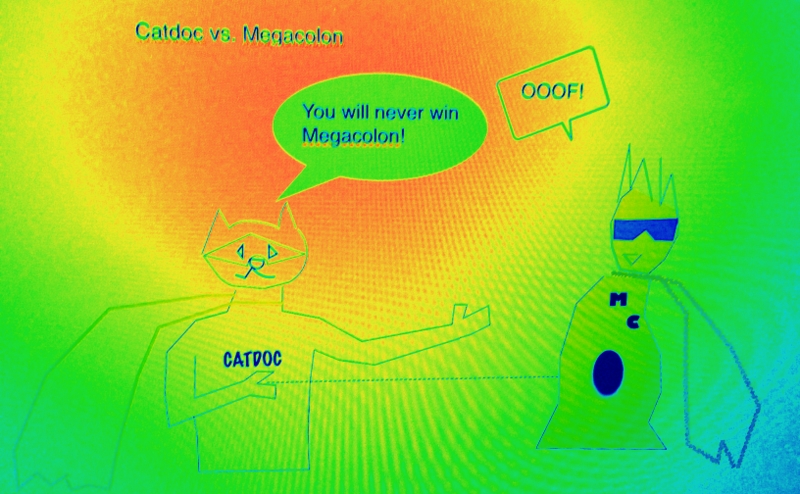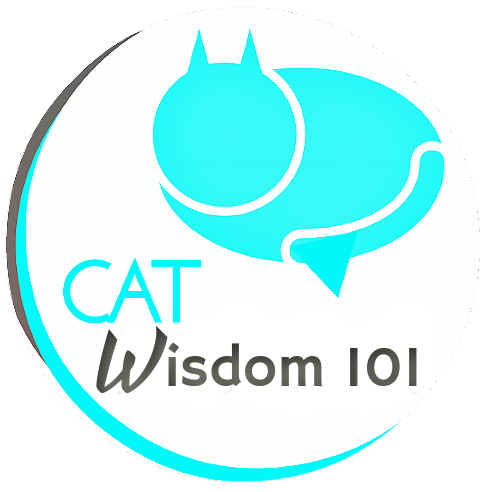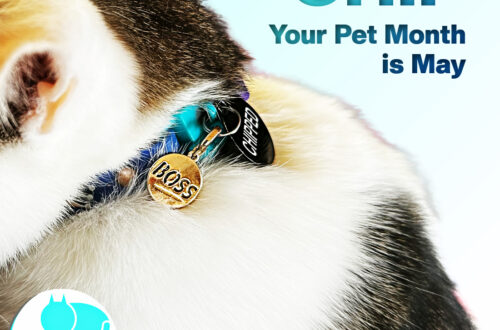Vet 101: The Super-Villain of the Bowel: Megacolon

Our guest post is Dr. Letrisa Miller who also created this cute cartoon. Her feline patients think she’s a super-hero. We do too for tackling the less than pleasant not informative topic of megacolon.
When a veterinarian enters the room, feels your cat’s abdomen and says the word megacolon, does a cartoon villain flash into your mind? Maybe you have a picture in your mind of a balloon-like character with a cape?
Megacolon actually has some things in common with super-villains. It rarely stays controlled with a single treatment, it is hard to defeat, and it usually comes back again. It also has only one sure treatment that defeats it, and that treatment can be a scary one that requires a superhero (Catdoc) to perform it.
First, though, you probably want to know what the disease is and what it causes. Megacolon is a dilation of the colon that can be caused by prolonged constipation or damage to the muscles in the wall of the colon.
It tends to be a very chronic problem and cats that have it usually have weight loss and poor hair coats. They don’t feel well so they don’t groom their coats much. They may vomit frequently and often defecate outside of the litter box. They have chronic pain and they often have hard feces that are eliminated in small pieces or pellets. Some cats have to have help passing feces. Cats with megacolon often have poor appetites because food cannot move through the gastrointestinal tract or moves through very slowly and they have abdominal pain.
Megacolon causes severe constipation, or what veterinarians call obstipation. This is a large build up of feces in the colon, and sometimes rectum, such that the cat cannot have a bowel movement. Sometimes enemas can soften the feces enough to allow passage through the anus, but most of the time the cat will have to be anesthetized for the veterinarian to work softeners into the stool and then manually work the feces out of the colon to relieve the blockage.
Cats that have megacolon have colons that are greatly enlarged, or dilated. In X-ray studies of the abdomen, the colon will look huge and have a large amount of feces in it. The colon sometimes gets as big as 3 inches in diameter!
Cats that have megacolon can be treated medically in many cases, but they are rarely cured. In general, once a cat has obvious dilation of the colon, the colon will never be normal again.
Modern medical treatment is to give canned diets that have low residue (low fiber) to decrease the bulk of the stool and increase the water in the cat’s system. Daily stool softeners like polyethylene glycol (PEG) or lactulose are given to soften the stools. The stool softeners are non-digestible sugars that draw water so that the feces stay moist and soft. Some cats also seem to respond to medication that increases the strength of smooth muscle contraction (cisapride), but cisapride can cause heart arrhythmias and has not been shown to be effective in clinical trials.
Older treatment included adding fiber to the diet, but that approach has been found to be counter-productive since the root problem is the inability of the colon to move material. If you increase the amount of fiber, it increases the amount of stool and can further compound the problem and just makes more work for the already weak muscles of the colon.
Medical treatments have to be given daily or constipation will come back. Any skipping of doses can mean a trip to the veterinarian and anesthesia for a cat with megacolon. The more times this happens, the more likely it is that the cat will eventually not respond to medical treatment, not to mention the risk of anesthesia and manual evacuation of the colon, so it is very important that medications are given exactly as prescribed.
For cats that still cannot move their bowels with regular medical treatments, the superhero (Catdoc) swoops in and removes the megacolon altogether. This is done by performing a sub-total colectomy surgery. In this surgery, the majority of the colon is removed. Some cats will have permanently soft stools after the surgery, but constipation and pain will be resolved.
The health of cats with megacolon usually improves amazingly after surgical treatment, unlike with medical treatment. Cats that get medical treatment have some improvement, but usually still have signs of pain and general ill health such as poor hair coats and being underweight.
Catdoc, the superhero really saves the day in this disease! Most cats that have colectomies have normal lives after the surgery. The evil megacolon is defeated and the cat is free to live a happy life!
Dr. Letrisa Miller has a feline exclusive practice in Manchester, Connecticut. Visit her website at Connecticut Feline Medicine and Surgery LLC




30 Comments
Jessica
My little o e is six months old and was adopted from a shelter. Upon adoption, I noticed she was not pooping and brought her to our vet. She was loosely diagnosed with mega colon. My question is, how old does a cat need to be to be eligible for the surgery? We have already spent thousands on her and would like to have a long happy life with her that doesn’t include frequent vet visits and daily medications (obviously I will do what is necessary! But long run wise, we have spent so much on small things it really seems that surgery might be the way to go (once she is of proper age). Thank you!
karen young
my cat midnite hasbeen on royal k9 for over a year and it was working fine ;but has stopped working i don’t know why i really dont know what to do now, has had 3 enamas in the last month any info would be nice thank-you
Layla Morgan Wilde
What does your vet say? Enemas are not meant for regular use. Try for more hydration from drinking fresh water, adding a little into food for a gray and no dry food
Barb
My17 year old has constipation ,a recent megacolon and a bowel stricture, with a 1 cm opening, she is sinking fast. I am sick about it, I need good ideas about food to give her
Anastasia
For all its worth, my tortie, Rozita had excruciating pain to defecate. I mean screaming with pain. After several vet visits for enemas, the last vet suggested Royal Canine Fibre Response. I am not advertising this brand, but I have to say it has helped tremendously. If this did not work I would have to consider the surgery. Try it before you make the decision to remove the colon.
Anastasia Kamai
For all its worth, my tortie, Rozita had excruciating paid to defecate. I mean screaming with pain. After several vet visits for enemas, the last vet suggested Royal Canine Fibre Response. I am not advertising this brand, but I have to say it was helped tremendously. If this did not work I would have to consider the surgery. Try it before you make the decision to remove the colon.
Sue Short
We’ve been feeding our cat Royal Canine Fibre Response for over 8 years now. She also has to have cisapride 3x a day at .67 ml each time, 15 minutes before her meals, and lactulose at 3 ml (approx.) 45 minutes after her meals. She’s had megacolon for over 9 years, and is currently 13. Cisapride can be a compounded liquid or in pill form. For our cat we find liquid is the easiest to give. We also give her some soft food, nothing special, once a day; not a large amount. I think after over 9 years she’s doing fairly well, only had to have an enema twice in that length of time. She usually only has a b.m. every 36-50 hours, and our Vet. said he’s content with up to 48 hours. I’ve heard you can’t get cisapride in Europe, just because it was a discontinued drug as it caused heart problems for humans, but totally safe for cats.
Kelly
My cat had to be emptied out at the vet’s. He’s been on a diet of dry Royal Canin for several months now and is doing very well. Yes, it’s expensive, but it definitely works.
Marie
What is royal canon and where do you get it?
Meg
Please please PLEASE HELP!!!!!
My cat, Romeo is a 3 year old American short hair. He has been to the hospital twice to evacuate the colon. I am trying to raise money via gofundme.com to save for his vet bills, food, and surgery if it comes to that… the vet says if he gets blocked up again they will put him down!!! I’m absolutely desperate to keep him healthy and completely TERRIFIED to bring him back to the vet and have them kill my baby…
Is there any food besides the Royal Canin GI fiber response that is good for megacolon?
I was looking at royal canin special, blue buffalo limited I gradient (but has more fiber, 6%), and wellness core(which seems best but is still very expensive.) I am struggling so bad financially and cannot afford $48 bags of food, I don’t want to give him away because I don’t know anyone else would take care of him the way he needs. He’s my baby, I love him and i just want him to be happy and healthy. Please help me find a food and save him, thank you so much!
BO Green eyes
If you order from chewy.com as an automatic monthly order it is $35ish for 8.8 lb. bag, the order must be $49.99 to get it at this price. You will have to get a Rx from the vet. Chewy.com will contact the vet, and I would call the vet. also tell them what you are doing. It is still about the same price but you can order the Jonny Cat liners to make up for the extra $ need to make the order the amount you need. These are the strongest liners I have found. I was also told to try different types of boxes. I don’t know if chewys has them I found plastic throw aways with litter for 4-5 bucks at PetSmart, he is curious about the new boxes and so far peeing in them. I plan to reuse them if possible. Hope this helps. Others try wet food with a drug and lactulose. Check out other sites. These way maybe more expensive. I don’t know. I know your pain as my 16-year-old has been dealing with this too.
ribbitfrog
Royal Canin Gastro Fiber Response has all but CURED my megacolon girl Olive! Its a recent formula they started offering when they redesigned their formulas this year. You’ll need a prescription to buy it from Petsmart or vet supply or online but, my GOD……it is like a miracle. $40 for 7lb bag lasts a good while. Now she no longer needs Miralax sprinkled in her food every other day, no enemas or straining in the last 3 months. It’s unbelievable. She feels great, plays hard, loves the food, fur is soft and healthy, weight is not too fat or too skinny. LOVE IT
The Island Cats
Thanks for this info. Our Zoey suffers from constipation…she poops about every 3-4 days, sometimes longer, despite being on cisapride, miralax, probiotics and a diet of canned food only. Fortunately she does go on her own, though I wonder what this is doing to her colon. The vet says that as long as she’s eating, not straining in the box, and otherwise acting normal, there’s not much else to do. Regular enemas are not a good option. If Dr. Miller has any other thoughts on this, we’d appreciate it.
Anonymous
I’m sorry to hear of your kitty’s plight. If she stays in good health, then staying with medical treatment may be a good option for you and her.
Look carefully at her overall health, though. If her coat is lacking in luster or she doesn’t seem to feel well, it may be time to consider surgery.
Surgery can make an amazing difference for these kitties with a return to excellent health in about 2 weeks to 1 month.
Anonymous
Pop, forgot to sign! The last one was from me.
Dr Miller
ribbitfrog
Royal Canin Gastro Fiber Response has all but CURED my megacolon girl Olive! Its a recent formula they started offering when they redesigned their formulas this year. You’ll need a prescription to buy it from Petsmart or vet supply or online but, my GOD……it is like a miracle. $40 for 7lb bag lasts a good while. Now she no longer needs Miralax sprinkled in her food every other day, no enemas or straining in the last 3 months. It’s unbelievable. She feels great, plays hard, loves the food, fur is soft and healthy, weight is not too fat or too skinny. LOVE IT
Skeeter and Izzy
Thank you Layla and Dr Miller. We were not aware that removal of the megacolon was an option nor that it was so effective. It is always so wonderful to learn something new about our cats and their health and well being. Thanks again!
Luvs
Skeeter and Izzy and The Feral Gang + Twig and Peanut and Romeo >^..^<
Angel AbbyGrace
Very good information on megacolon. Thankfully there is medical things that help deal with this.
Brian Frum
That was great info. We were concerned because I was constipated really bad once, but everything came out alright!
Tamago
Thank you for your information!
I didn’t know adding fiber would be counter-productive but it makes sense.
Oui Oui
Thanks for talking about this! I thought it was untreatable because I’ve heard of a cat that had to be put down because of it. I understand young kittens who have lost their mother are at risk if their human caretakers don’t know to stimulate them into having bowel movements.
Alana
I’ve heard about this a few times recently. This is really helpful to understand it better and something I definitely will watch out for as my cats get older.
easy rider
the cartoon explains it the best. many thanks for picking such interesting topics, Ive learnt so much things while reading your posts :o)
da tabbies o trout towne
doodz…tahnx for sahrin thiz post….we haz hurd bout de nastee megacolon but never new treetmint wuz sew rigorous….
🙁
da tabbies o trout towne
N look…we haz spellin izzues two day…how bout THANX for SHARIN ~~~
Fur Everywhere
Megacolon sounds terrible! Thank you for sharing information about it, though. It is important for cat parents to know.
Sometimes, Cats Herd You
Great explanation. It seems like there have been several cats in the blogosphere with megacolon recently, and it’s great to get an approachable explanation about it. Also, the cartoon is a hoot!
Cary Hillman
Thank you for sharing, Layla. I love your blog. I smile when I see your posts and I often learn something new. 🙂
Layla Morgan Wilde (Cat Wisdom 101)
Thanks Cary! It’s readers like you that make the hard work worthwhile.
Kathryn
oh wow, such good information. I hope Ched and Mao don’t get this. We feed them mostly the prescription food – urinary and dissolution formula, as Cheddar got crystals two years ago. I do feed them SOME regular canned food and a bit of regular dry food, but mostly the prescription food from Royal Canin for cats.